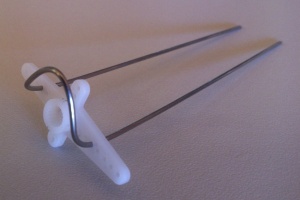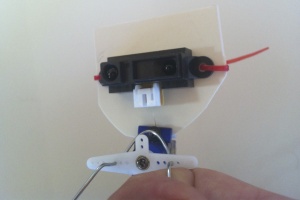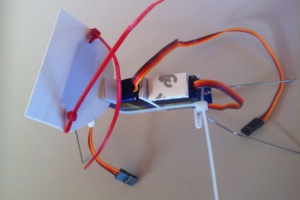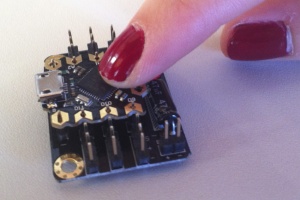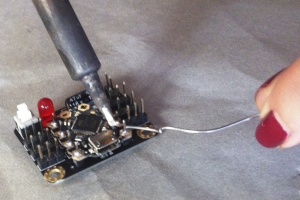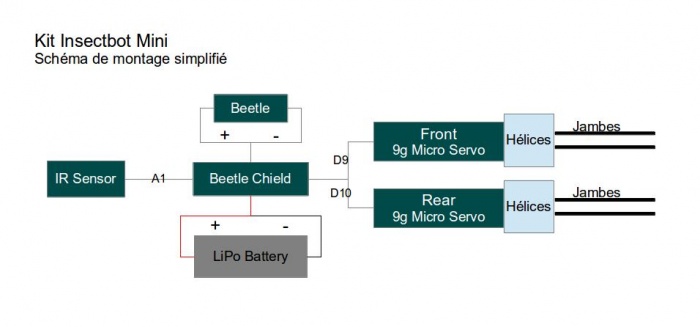Insect bot
De Wikidebrouillard.
| (64 versions intermédiaires masquées) | |||
| Ligne 1 : | Ligne 1 : | ||
| - | {{avertissement}} | + | {{avertissement}} |
| - | {{vidéo|numérovidéo = <videoflash type="mediaspip" num ="1">http:// | + | {{vidéo|numérovidéo = <videoflash type="mediaspip" num ="1">http://ifaidy.infini.fr/stockage/forum2014/insectbot/insectbot.ogv|400|300</videoflash>}} |
==Présentation du projet Insectbot== | ==Présentation du projet Insectbot== | ||
| + | Robot électromécanique autonome avec senseur/capteur infrarouge pour évitement d'obstacles, à monter en kit. | ||
| + | Créer en Chine par Lutz Michaelis, sur cet atelier nous utilisons la version distribué par DFRobot. | ||
| + | [https://www.facebook.com/lumi3005] | ||
| + | [http://www.dfrobot.com] | ||
| + | |||
| + | Robot électromécanique autonome avec senseur infrarouge pour évitement d'obstacles, à monter en kit. | ||
| + | Créer en Chine par Lutz Michaelis, sur cet atelier nous utilisons la version distribué par DFRobot. | ||
| + | [https://www.facebook.com/lumi3005] | ||
| + | [http://www.dfrobot.com] | ||
| + | |||
| + | [[Média:http://ifaidy.infini.fr/stockage/forum2014/insectbot/insectbot.ogv|Vidéo au format ogv]] | ||
| + | |||
| + | [[Média:http://ifaidy.infini.fr/stockage/forum2014/insectbot/insectbot.mp4|Vidéo au format mp4]] | ||
===Animateur:=== | ===Animateur:=== | ||
Habib | Habib | ||
| + | [https://www.facebook.com/groups/bbmakers/] | ||
| + | |||
===Participants:=== | ===Participants:=== | ||
| - | Claude, Thierry, Igor, Olivier | + | Jour 1 : |
| + | Claude, | ||
| + | Thierry, | ||
| + | Igor, | ||
| + | Olivier, | ||
| + | Yvan | ||
| - | + | Jour 2 : | |
| + | Rachel, | ||
| + | Charlotte, | ||
| + | Alice, | ||
| + | Moosh | ||
==Liste du matériel== | ==Liste du matériel== | ||
| - | DIY Kit Insectbot Mini | + | DIY Kit Insectbot Mini |
| + | |||
Les références indiqués sont celles du vendeur DFRobot | Les références indiqués sont celles du vendeur DFRobot | ||
| - | * [[Image:| | + | * [[Image:Bettle_DFRobot.jpg|80px]] 1x Carte DFRobot Beetle Arduino |
| - | * [[Image:| | + | * [[Image:Beetle_Shield_DFRobot.jpg|80px]] 1x Carte DFRobot Beetle Shield v0.4 |
| - | * [[Image:Servomoteur.jpg| | + | * [[Image:Servomoteur.jpg|80px]] 2x Micro [[Servomoteur]] SG90 (ref:SER006) |
| - | * | + | * 1x Senseur Infrarouge Sharp 2YOPA21 (ref:SEN0014) |
* 1x Batterie LiPo 3.7V/180mAh avec un chargeur USB | * 1x Batterie LiPo 3.7V/180mAh avec un chargeur USB | ||
* 2x Tiges Acier 200mm x 1mm | * 2x Tiges Acier 200mm x 1mm | ||
| Ligne 26 : | Ligne 51 : | ||
* 1x collier serflex 200mm | * 1x collier serflex 200mm | ||
| - | * [[Image:Ordi.jpg| | + | * [[Image:Ordi.jpg|80px]][[Image:Arduino_Uno_logo.png|80px]] Un [[ordinateur]] et le logiciel [[Arduino]] pour charger le programme |
==Réalisation du projet== | ==Réalisation du projet== | ||
| + | |||
| + | ===Assemblage=== | ||
/* ♥ LE GROUPE DES FILLES REMPLIE ICI ♥ */ | /* ♥ LE GROUPE DES FILLES REMPLIE ICI ♥ */ | ||
| - | + | ||
| - | http://www.instructables.com/id/Insect-Bot-mini/ | + | Guide de montage : http://www.instructables.com/id/Insect-Bot-mini/ |
| + | |||
| + | [[Image:Arduino_Insectbot_Tuto_01.jpg|300px]] | ||
| + | [[Image:Arduino_Insectbot_Tuto_02.jpg|300px]] | ||
| + | [[Image:Arduino_Insectbot_Tuto_03.jpg|300px]] | ||
| + | [[Image:Arduino_Insectbot_Tuto_04.jpg|300px]] | ||
| + | [[Image:Arduino_Insectbot_Tuto_05.jpg|300px]] | ||
| + | [[Image:Arduino_Insectbot_Tuto_06.jpg|300px]] | ||
| + | [[Image:Arduino_Insectbot_Tuto_07.jpg|300px]] | ||
| + | [[Image:Arduino_Insectbot_Tuto_08.jpg|300px]] | ||
| + | [[Image:Arduino_Insectbot_Tuto_09.jpg|300px]] | ||
| + | [[Image:Arduino_Insectbot_Tuto_10.jpg|300px]] | ||
| + | |||
| + | Observations/Erreurs à ne pas faire : | ||
| + | |||
| + | [graoulab] : il faut faire attention en pliant les pattes. Les tiges sont pointues et rentrent facilement dans les doigts. | ||
| + | |||
===Schéma=== | ===Schéma=== | ||
| + | [[Image:Schema_kit_insectbot.jpg|700px]] | ||
| + | |||
| + | ===Chargement du programme=== | ||
| + | [Image ordinateur logiciel Arduino relier en USB au robot] | ||
| + | Le programme : http://www.instructables.com/files/orig/FZN/1FYV/HP0CIEUH/FZN1FYVHP0CIEUH.rar | ||
===Code=== | ===Code=== | ||
| Ligne 204 : | Ligne 252 : | ||
==Liens avec d'autres projets arduino== | ==Liens avec d'autres projets arduino== | ||
chercher ici : http://wikidebrouillard.org/index.php/Catégorie:Arduino | chercher ici : http://wikidebrouillard.org/index.php/Catégorie:Arduino | ||
| + | |||
| + | http://wikidebrouillard.org/index.php/Robot_autonome_de_type_Roomba | ||
| + | |||
| + | http://wikidebrouillard.org/index.php/Robot_%C3%A9lectro-m%C3%A9canique | ||
| + | |||
| + | http://wikidebrouillard.org/index.php/Capteur_de_pr%C3%A9sence | ||
==Pour aller plus loin== | ==Pour aller plus loin== | ||
| + | |||
| + | ==Journee Graoulab== | ||
| + | |||
| + | Vendredi 8 Août 2014, Metz, Lorraine, France | ||
| + | |||
| + | lien pour le site du Graoulab =>[http://www.graoulab.org] | ||
| + | |||
| + | 6 insectes construits | ||
| + | |||
| + | 5 marchent normalement et un autre a des soucis avec le capteur. L'atelier est ludique c'est drôle. C'est compliqué mais on apprend plein de nouvelles choses. Attention à la tête, elle penche et casse(support en plastique blanc). L'animation de l'atelier couvre toutes les étapes et devient une excellente base pour poursuivre. | ||
==Liens avec le quotidien== | ==Liens avec le quotidien== | ||
quelles peuvent être les applications technologiques de ce montage, ou est-ce qu'on retrouve des programmes qui y ressemble ? | quelles peuvent être les applications technologiques de ce montage, ou est-ce qu'on retrouve des programmes qui y ressemble ? | ||
| + | |||
| + | |||
| + | ==Journee Zbis | ||
| + | |||
| + | Pour faire les trous de fixation des capteurs optiques, une bonne méthode: prenez une paire de ciseaux plantez une des lame verticalement sur la plaquette plastique, à l'endroit ou vous souhaitez faire ce trou, et faites la pivoter, dans un sens puis dans l'autre jusqu'au perçage. | ||
| + | Un problème est survenu! Notre "insect bot" ne fait que reculer! Mais si on débranche le capteur optique, il avance normalement. Quelqu'un a-t-il déjà eu ce problème??? A-t-il trouvé la solution? | ||
| + | Merci ;) | ||
| + | |||
[[Catégorie:Arduino]] | [[Catégorie:Arduino]] | ||
Version actuelle en date du 11 août 2014 à 19:13
Sommaire |
Présentation du projet Insectbot
Robot électromécanique autonome avec senseur/capteur infrarouge pour évitement d'obstacles, à monter en kit. Créer en Chine par Lutz Michaelis, sur cet atelier nous utilisons la version distribué par DFRobot. [1] [2]
Robot électromécanique autonome avec senseur infrarouge pour évitement d'obstacles, à monter en kit. Créer en Chine par Lutz Michaelis, sur cet atelier nous utilisons la version distribué par DFRobot. [3] [4]
Animateur:
Habib [5]
Participants:
Jour 1 : Claude, Thierry, Igor, Olivier, Yvan
Jour 2 : Rachel, Charlotte, Alice, Moosh
Liste du matériel
DIY Kit Insectbot Mini
Les références indiqués sont celles du vendeur DFRobot
-
 1x Carte DFRobot Beetle Arduino
1x Carte DFRobot Beetle Arduino
-
 1x Carte DFRobot Beetle Shield v0.4
1x Carte DFRobot Beetle Shield v0.4
-
 2x Micro Servomoteur SG90 (ref:SER006)
2x Micro Servomoteur SG90 (ref:SER006)
- 1x Senseur Infrarouge Sharp 2YOPA21 (ref:SEN0014)
- 1x Batterie LiPo 3.7V/180mAh avec un chargeur USB
- 2x Tiges Acier 200mm x 1mm
- 1x Feuille de plastique de 50 x 50mm
- 1x scotch double face 40x30mm
- 5x colliers serflex 100mm
- 1x collier serflex 200mm
-

 Un ordinateur et le logiciel Arduino pour charger le programme
Un ordinateur et le logiciel Arduino pour charger le programme
Réalisation du projet
Assemblage
/* ♥ LE GROUPE DES FILLES REMPLIE ICI ♥ */
Guide de montage : http://www.instructables.com/id/Insect-Bot-mini/
Observations/Erreurs à ne pas faire :
[graoulab] : il faut faire attention en pliant les pattes. Les tiges sont pointues et rentrent facilement dans les doigts.
Schéma
Chargement du programme
[Image ordinateur logiciel Arduino relier en USB au robot]
Le programme : http://www.instructables.com/files/orig/FZN/1FYV/HP0CIEUH/FZN1FYVHP0CIEUH.rar
Code
// /////////////////////////////////////////////////////////////////
// INSECT BOT MINI //
// //
// modified by Lumi for DFRobot.com //
// 2013/10/26 //
////////////////////////////////////////////////////////////////////
// Servo Library
#include <Servo.h>
// Servo name
Servo frontServo;
Servo rearServo;
// time delay between steps
int walkSpeed = 500;
// center servos
int centerPos = 90;
// servo angles for walking pattern
int frontRightUp = 70;
int frontLeftUp = 110;
int backRightForward = 70;
int backLeftForward = 110;
// another center position
int centerTurnPos = 81;
// servo angles for walking pattern
int frontTurnRightUp = 70;
int frontTurnLeftUp = 110;
int backTurnRightForward = 70;
int backTurnLeftForward = 110;
// variable for distance value
int distance = 0;
// average distance value
int distanceCheck = 0;
// Array for distance values
int collectDistance[5];
// Variables for counters
int i;
int f;
int r;
// assign analog pin A1
int sensorPin = A1;
// distance value for danger close. Bigger values are greater distance and smaller values are lower distance
int dangerDistance = 350;
/* Setup function */
void setup()
{
// attach servos
frontServo.attach(9);
rearServo.attach(10);
// assign sensor
pinMode(sensorPin, INPUT);
// center servos
frontServo.write(centerPos);
rearServo.write(centerPos);
// wait 3 seconds for start walking
delay(3000);
//Serial.begin(9600); // serial data setup
}
/* distance check function */
void scan()
{
// read 5 distance values
for (i = 0; i < 5; i = i + 1) {
distanceCheck = analogRead(sensorPin);
collectDistance[i] = distanceCheck;
// serial output for testing
//Serial.print (i);
//Serial.print(" = ");
//Serial.println(collectDistance[i]);
}
// checksum of the 5 distance values for getting an average value. This will prevent the robot to change behavior by reading one wrong value
distance = (collectDistance[0]+collectDistance[1]+collectDistance[2]+collectDistance[3]+collectDistance[4])/5;
delay(20);
}
// walk forward
void moveForward()
{
// loop for the servo angels to smoothen the steps
for (f = 0; f < 39; f++){
frontRightUp++;
backLeftForward--;
frontServo.write(frontRightUp);
rearServo.write(backLeftForward);
delay(10);
}
// loop for the servo angels to smoothen the steps
for (r = 0; r < 39; r++){
frontRightUp--;
backLeftForward++;
frontServo.write(frontRightUp);
rearServo.write(backLeftForward);
delay(10);
}
}
// walk backwards to the left
void moveBackRight()
{
frontServo.write(frontRightUp);
rearServo.write(backRightForward-6);
delay(110);
frontServo.write(centerPos);
rearServo.write(centerPos-6);
delay(80);
frontServo.write(frontLeftUp+9);
rearServo.write(backLeftForward-6);
delay(110);
frontServo.write(centerPos);
rearServo.write(centerPos);
delay(80);
}
// walk forward to the left
void moveTurnLeft()
{
frontServo.write(frontTurnRightUp);
rearServo.write(backTurnLeftForward);
delay(110);
frontServo.write(centerTurnPos);
rearServo.write(centerTurnPos);
delay(80);
frontServo.write(frontTurnLeftUp);
rearServo.write(backTurnRightForward);
delay(110);
frontServo.write(centerTurnPos);
rearServo.write(centerTurnPos);
delay(80);
}
// blink LED. This function can be called in any situation you want. Just add led(); in the code where you want to blink the LED.
void led(){
// loop for the LED to blink it 5 times for 0.05 sec on and 0.1 sec off
for(int l=0; l<=5; l++) {
digitalWrite(13, HIGH);
delay(50);
digitalWrite(13, LOW);
delay(100);
}
}
// that's the loop. This is repeatedly called as long as the robot is powered on
void loop()
{
// call function for checking the distance
scan();
//Serial.println(distance);
if (distance > 1){ // filters out the zero readings
// an obstacle is being detected
if (distance > dangerDistance) {
// LED at Pin 13 (standard) blinks 5x
led();
// 4 steps backward left
for(int i=0; i<=3; i++) {
moveBackRight();
delay(walkSpeed);
}
// 4 steps forward left
for(int i=0; i<=3; i++) {
moveTurnLeft();
delay(walkSpeed);
}
} else {
// all clear, no obstacle detected. Just walk forward
moveForward();
delay(walkSpeed/100);
}
}
}
Liens avec d'autres projets arduino
chercher ici : http://wikidebrouillard.org/index.php/Catégorie:Arduino
http://wikidebrouillard.org/index.php/Robot_autonome_de_type_Roomba
http://wikidebrouillard.org/index.php/Robot_%C3%A9lectro-m%C3%A9canique
http://wikidebrouillard.org/index.php/Capteur_de_pr%C3%A9sence
Pour aller plus loin
Journee Graoulab
Vendredi 8 Août 2014, Metz, Lorraine, France
lien pour le site du Graoulab =>[6]
6 insectes construits
5 marchent normalement et un autre a des soucis avec le capteur. L'atelier est ludique c'est drôle. C'est compliqué mais on apprend plein de nouvelles choses. Attention à la tête, elle penche et casse(support en plastique blanc). L'animation de l'atelier couvre toutes les étapes et devient une excellente base pour poursuivre.
Liens avec le quotidien
quelles peuvent être les applications technologiques de ce montage, ou est-ce qu'on retrouve des programmes qui y ressemble ?
==Journee Zbis
Pour faire les trous de fixation des capteurs optiques, une bonne méthode: prenez une paire de ciseaux plantez une des lame verticalement sur la plaquette plastique, à l'endroit ou vous souhaitez faire ce trou, et faites la pivoter, dans un sens puis dans l'autre jusqu'au perçage. Un problème est survenu! Notre "insect bot" ne fait que reculer! Mais si on débranche le capteur optique, il avance normalement. Quelqu'un a-t-il déjà eu ce problème??? A-t-il trouvé la solution? Merci ;)
- Dernière modification de cette page le 11 août 2014 à 19:13.
- Cette page a été consultée 74 240 fois.
- Contenu disponible sous Creative Commons - Paternite Partage a l'identique (CC-BY-SA).
- Politique de confidentialité
- À propos de Wikidebrouillard
- Avertissements

